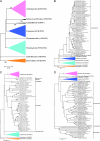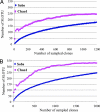Molecular analysis of human forearm superficial skin bacterial biota
- PMID: 17293459
- PMCID: PMC1815283
- DOI: 10.1073/pnas.0607077104
Molecular analysis of human forearm superficial skin bacterial biota
Abstract
The microbial ecology of human skin is complex, but little is known about its species composition. We examined the diversity of the skin biota from the superficial volar left and right forearms in six healthy subjects using broad-range small subunit rRNA genes (16S rDNA) PCR-based sequencing of randomly selected clones. For the initial 1,221 clones analyzed, 182 species-level operational taxonomic units (SLOTUs) belonging to eight phyla were identified, estimated as 74.0% [95% confidence interval (C.I.), approximately 64.8-77.9%] of the SLOTUs in this ecosystem; 48.0 +/- 12.2 SLOTUs were found in each subject. Three phyla (Actinobacteria, Firmicutes, and Proteobacteria) accounted for 94.6% of the clones. Most (85.3%) of the bacterial sequences corresponded to known and cultivated species, but 98 (8.0%) clones, comprising 30 phylotypes, had <97% similarity to prior database sequences. Only 6 (6.6%) of the 91 genera and 4 (2.2%) of the 182 SLOTUs, respectively, were found in all six subjects. Analysis of 817 clones obtained 8-10 months later from four subjects showed additional phyla (numbering 2), genera (numbering 28), and SLOTUs (numbering 65). Only four (3.4%) of the 119 genera (Propionibacteria, Corynebacteria, Staphylococcus, and Streptococcus) were observed in each subject tested twice, but these genera represented 54.4% of all clones. These results show that the bacterial biota in normal superficial skin is highly diverse, with few well conserved and well represented genera, but otherwise low-level interpersonal consensus.
Conflict of interest statement
The authors declare no conflict of interest.
Figures




Similar articles
-
Molecular analysis of the prevalent microbiota of human male and female forehead skin compared to forearm skin and the influence of make-up.J Appl Microbiol. 2011 Jun;110(6):1381-9. doi: 10.1111/j.1365-2672.2011.04991.x. Epub 2011 Mar 17. J Appl Microbiol. 2011. PMID: 21362117
-
Molecular analyses of microbial diversity associated with the Lonar soda lake in India: an impact crater in a basalt area.Res Microbiol. 2006 Dec;157(10):928-37. doi: 10.1016/j.resmic.2006.08.005. Epub 2006 Oct 9. Res Microbiol. 2006. PMID: 17070674
-
Bacterial diversity of subgingival plaque in 6 healthy Chinese individuals.Exp Ther Med. 2011 Sep;2(5):1023-1029. doi: 10.3892/etm.2011.311. Epub 2011 Jun 30. Exp Ther Med. 2011. PMID: 22977615 Free PMC article.
-
Phylogenetic diversity of bacteria in the leachate of a full-scale recirculating landfill.FEMS Microbiol Ecol. 2004 Nov 1;50(3):175-83. doi: 10.1016/j.femsec.2004.06.008. FEMS Microbiol Ecol. 2004. PMID: 19712358
-
Bacterial biota in the human distal esophagus.Proc Natl Acad Sci U S A. 2004 Mar 23;101(12):4250-5. doi: 10.1073/pnas.0306398101. Epub 2004 Mar 11. Proc Natl Acad Sci U S A. 2004. PMID: 15016918 Free PMC article.
Cited by
-
Bacterial Analysis of the Whole Blood in Chinese Healthy Donors Using 16S rDNA-Targeted Metagenomic Sequencing.Can J Infect Dis Med Microbiol. 2024 Oct 16;2024:6635560. doi: 10.1155/2024/6635560. eCollection 2024. Can J Infect Dis Med Microbiol. 2024. PMID: 39444936 Free PMC article.
-
The Janus-Face of Bacteriophages across Human Body Habitats.PLoS Pathog. 2016 Jun 23;12(6):e1005634. doi: 10.1371/journal.ppat.1005634. eCollection 2016 Jun. PLoS Pathog. 2016. PMID: 27337144 Free PMC article. Review. No abstract available.
-
Body Site Is a More Determinant Factor than Human Population Diversity in the Healthy Skin Microbiome.PLoS One. 2016 Apr 18;11(4):e0151990. doi: 10.1371/journal.pone.0151990. eCollection 2016. PLoS One. 2016. PMID: 27088867 Free PMC article.
-
Exploring the feasibility of bioaerosol analysis as a novel fingerprinting technique.Anal Bioanal Chem. 2012 Apr;403(1):15-26. doi: 10.1007/s00216-012-5725-0. Epub 2012 Feb 4. Anal Bioanal Chem. 2012. PMID: 22311424 Free PMC article. Review.
-
Passenger-surface microbiome interactions in the subway of Mexico City.PLoS One. 2020 Aug 19;15(8):e0237272. doi: 10.1371/journal.pone.0237272. eCollection 2020. PLoS One. 2020. PMID: 32813719 Free PMC article.
References
-
- Fredricks DN. J Investig Dermatol Symp Proc. 2001;6:167–169. - PubMed
-
- Holland KT, Bojar RA. Am J Clin Dermatol. 2002;3:445–449. - PubMed
-
- Leyden JJ, McGinley KJ, Nordstrom KM, Webster GF. J Invest Dermatol. 1987;88:65s–72s. - PubMed
-
- Roth RR, James WD. Annu Rev Microbiol. 1988;42:441–464. - PubMed
-
- Noble WC. Br J Dermatol. 1998;139(Suppl 53):9–12. - PubMed
Publication types
MeSH terms
Substances
Associated data
- Actions
- Actions
- Actions
- Actions
- Actions
- Actions
- Actions
- Actions
- Actions
- Actions
- Actions
- Actions
- Actions
- Actions
- Actions
- Actions
- Actions
- Actions
- Actions
- Actions
- Actions
- Actions
- Actions
- Actions
- Actions
- Actions
- Actions
- Actions
- Actions
- Actions
- Actions
- Actions
- Actions
- Actions
- Actions
- Actions
- Actions
- Actions
- Actions
- Actions
- Actions
- Actions
- Actions
- Actions
Grants and funding
LinkOut - more resources
Full Text Sources
Other Literature Sources
Molecular Biology Databases

